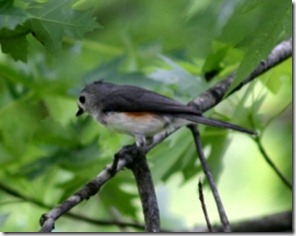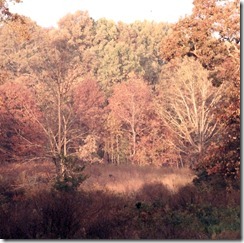Saturday morning I was curled up in a blanket watching Bob Ross paint a winter landscape on PBS. I was enjoying his rapturous meditation on loving life and the subtle nuances of painting glacial mountains against a blue sky when a slight movement outside the window caught my eye. Like a cat to a bit of bright yarn, my eyes were immediately drawn to a silky grey titmouse flirting in the low branches of the oak tree.
The tufted titmouse (Baeolophus bicolor) is an enchanting little bird. Dull in coloration, its head, back and tail feathers are a simple, soft mousey-gray. It has a creamy white breast and belly with just a touch of rust at the sides. It is the pert crest rising from its crown that gives this less than flashy bird a sleek, yet playful appearance.
It is uncommon to see titmice in the summer. During breeding, they stay in solitary mating pairs and their calls are not pronounced. After breeding, they move into large, very noticeable social groups. Like me, this is why most people think of titmice as “winter birds”. This one is alone and I wonder where the rest of his group are, and when he takes flight towards the meadow, I quickly set out to follow him.
 The meadow, protected by a curving ridge and ringed with trees, is an important part of the watershed for the ridge that wraps around the property. The meadow gathers and sifts rainwater before it makes its way down a swale to the hollow below and ultimately, all the way to the North Fork River. The edge of this occasionally wet place is thick with low brush and blackberry. The center of the meadow appears to be an impenetrable mass of ragweed 4’ tall. Since our arrival here a few months ago I have silently cursed the ragweed for its abundance and persistence. I am not one who suffers from ragweed allergies, but this plant is definitely not in my perfect vision of a meadow. My dream meadow is filled with beautiful wildflowers and native grasses that feed and attract birds and butterflies.
The meadow, protected by a curving ridge and ringed with trees, is an important part of the watershed for the ridge that wraps around the property. The meadow gathers and sifts rainwater before it makes its way down a swale to the hollow below and ultimately, all the way to the North Fork River. The edge of this occasionally wet place is thick with low brush and blackberry. The center of the meadow appears to be an impenetrable mass of ragweed 4’ tall. Since our arrival here a few months ago I have silently cursed the ragweed for its abundance and persistence. I am not one who suffers from ragweed allergies, but this plant is definitely not in my perfect vision of a meadow. My dream meadow is filled with beautiful wildflowers and native grasses that feed and attract birds and butterflies.
Though I’ve lost sight of the titmouse I was following, I listen for its call. Often heard before they are seen titmice keep up an almost constant chatter while foraging. Their calls consist of several sounds including a whistling “pe-ter, pe-ter”, or a raspy “cher-cher-cher” or “tsee-day-day-day”, but they also have a series of lovely little songs similar to those of the Carolina wren.
For being only 6½” long titmice make a big presence in woodlands, especially when they gang up with other small birds. In an incredible statement to the inclusive intention of creation, titmice like to live not only with birds of their own kind, but with those of other species as well. They particularly seem to enjoy the company of nuthatches, downy and hairy woodpeckers, chickadees, juncos and brown creepers.
Just a moment ago I was watching Bob Ross paint. I had been thinking that his painting instruction was less about painting than about kindness, humility and above all, nature. While demonstrating a particular method for painting trees or rocks, he often says, “It’s your world. Make it the way you want it to be.”
 As I near the meadow I hear the titmice – lots of them – and they’ve brought some friends. The ragweed is alive with little birds working the stems for seeds and insects. There are hundreds of birds here.
As I near the meadow I hear the titmice – lots of them – and they’ve brought some friends. The ragweed is alive with little birds working the stems for seeds and insects. There are hundreds of birds here.
I haven’t been down to the meadow in a long time and now that the vegetation has died back a little I can see so many wonderful plants growing amidst the ragweed including aster, goldenrod, yarrow, salvia, mullein, native lespedeza and a host of native grasses.
The meadow is suddenly transformed from a weedy nuisance to the wildlife haven I had envisioned. Not only was it an important food source for many different types of birds, including wild turkey and the resident goshawk family that I have seen hunting here. But deer browse the tender grasses beneath the ragweed and turtles and frogs find shelter and food in abundance. No doubt there are many other creatures that I still can’t or haven’t seen that use the meadow for one purpose or the other.
I had been saying for months I was going to turn this meadow into a wildflower garden some day, but it was already here – I just didn’t see it in the right light. But this meadow is better than the one in my dream because it is perfectly suited to fulfill an important role in nature – one far better than I could have ever made it.
When Bob Ross paints nature, what you see is his vision of the world as he believes it should be – wild and untamed. This was his dream. A peaceful place so full of beauty and inspiration that it was too perfect to be real. He wanted to awe us with its perfection. He tried to show us how to make such a world in our paintings and then challenged us to make that world a reality. With a soft chuckle and a slight nod, Bob conspired with us, saying, Seriously – this is your world! The only one there will ever be. Take care of it. Love it. Make it better.
And as I watch the titmice bob and weave through the leafless stems of ragweed, it dawns on me that I am now the steward of this land. It is up to me to decide what will happen to it. I have the power to make it whatever I want it to be, or to simply let it be what it already is. Perfect.
Jill Henderson is an artist, author and the editor of Show Me Oz © 2011 Jill Henderson
 Parts of this article were excerpted from
Parts of this article were excerpted from
A Journey of Seasons:
A Year in the Ozarks High Country
A Journey of Seasons is a beautifully recounted story of life on a rural Missouri homestead. Based on the changing landscape of the seasons and filled with nature notes, botanical musings, back-woods wisdom and just a pinch of hillbilly humor, noted author, naturalist and organic gardener, Jill Henderson, spins a story of delight and enchantment. This is one journey you don’t want to miss!
Paperback: $18.00 www.createspace.com/3477718
E-books: $5.99 www.smashwords.com/books/view/17077
Kindle: $5.99 www.amazon.com/dp/B0050ZIB6U
DID YOU LIKE THIS ARTICLE?
DON’T MISS A SINGLE ISSUE – SUBSCRIBE TODAY!
…and don’t forget to tell your friends you got it from











I really resonate with your account of the delight of this kind of discovery here Jill! How wonderful to be led by (and be aware enough to follow) a little bird. The interesting thing about a new place (or even a place you’ve lived in for a while) is waiting to see what it has to show you before making too many changes. Last week, alerted by the changing leaf color, I found a grove of baby persimmon trees right behind the cabin. I’ve tagged them so that I can make sure I ‘cultivate’ them. So much better than planting them – I already know they like that position.
I’m so excited for you! Those persimmon trees are like a little present for all your efforts in rehabilitating your woods after those devastating storms! Isn’t it amazing how they just pop up like that when given an opportunity?! And now you also have a nursery from which to spread that little joy! I, too, am on the lookout for a persimmon patch here in our woods. I know there’s bound to be some, I just haven’t found them yet. Perhaps a little birdie will show me the way!